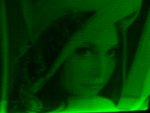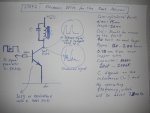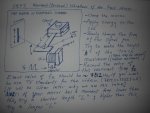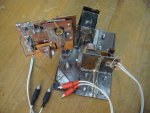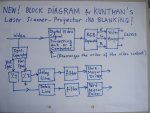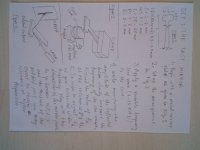- Joined
- Apr 28, 2009
- Messages
- 63
- Points
- 8
NEW FIGURE FOR TUNING THE FAST MIRROR.
Figures for the fast mirror and for high speed analog modulation of DPSS green laser.
In this project, by means of two mirrors (which can be tilted about two perpendicular axis) we deflect the laser beam to scan a rectangular screen and modulate the laser source to obtain a colored image on the screen. [highlight]We don’t make use of sophisticated devices such as MEMS micromirror and acousto-optical-modulators.[/highlight]
Max. speed of the fast axis mirror is 25 KHz. That corresponds to 50000 back and fro lines per second.
In order to make use of the conventional video signal, frequency of the present scanner is tuned to 15625/2 (Hz.)
- Vibrations of both axis are resonant, therefore sinusoidal.
- Restoring force on the fast mirror is very strong and it has a very sharp resonance,
hence practically there is no phase drift;
position detectors and feedback phase control mechanisms are not required.
- Fast axis is elecromagnetically driven.
- Laser modulation is analog.
Videos:
YouTube - homemade laser projector tv (no-MEMS, no-AOM)
YouTube - laser tv (without MEMS)
Figures for the fast mirror and for high speed analog modulation of DPSS green laser.
In this project, by means of two mirrors (which can be tilted about two perpendicular axis) we deflect the laser beam to scan a rectangular screen and modulate the laser source to obtain a colored image on the screen. [highlight]We don’t make use of sophisticated devices such as MEMS micromirror and acousto-optical-modulators.[/highlight]
Max. speed of the fast axis mirror is 25 KHz. That corresponds to 50000 back and fro lines per second.
In order to make use of the conventional video signal, frequency of the present scanner is tuned to 15625/2 (Hz.)
- Vibrations of both axis are resonant, therefore sinusoidal.
- Restoring force on the fast mirror is very strong and it has a very sharp resonance,
hence practically there is no phase drift;
position detectors and feedback phase control mechanisms are not required.
- Fast axis is elecromagnetically driven.
- Laser modulation is analog.
Videos:
YouTube - homemade laser projector tv (no-MEMS, no-AOM)
YouTube - laser tv (without MEMS)
Attachments
Last edited:


